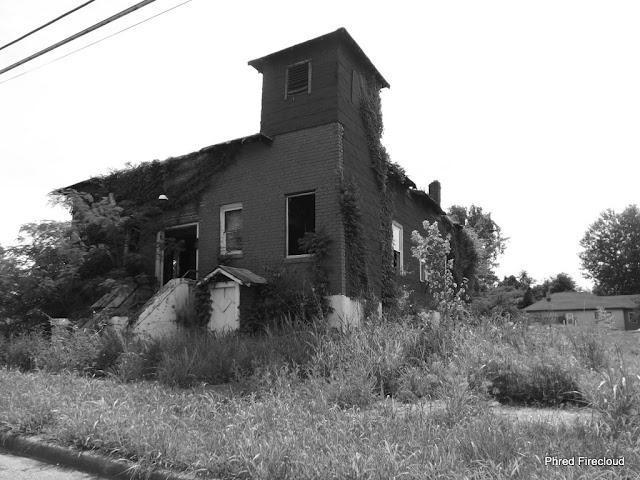CROSSVILLE, Tenn. — Horace Burgess's treehouse may be as close to heaven as a body can get in Cumberland County.
(Photos by Mrs. Phred. Text by USA.Today.COM)
It rises 97 feet into the sky, the support
provided by a live, 80-foot-tall white oak 12 feet in diameter at its
base. Six other trees brace the tower-like fortress, but Burgess says
its foundation is in God.
"I built it for everybody. It's God's treehouse.
He keeps watch over it," said Burgess, who received his inspiration in a
vision that came to him in 1993. "I was praying one day, and the Lord
said, 'If you build me a treehouse, I'll see you never run out of
material."'
And thus far, as Burgess sees it, the Lord has
provided. Most of his materials are recycled pieces of lumber from
garages, storage sheds and barns. Now into his 14th year of
construction, he is not finished.
The treehouse has 10 floors, averaging nine to 11
feet in height by Burgess's reckoning. He has never measured its size
but estimates it to be about 8,000 to 10,000 square feet. He did count
the nails that he has hammered into the wood — 258,000, give or take a
few hundred. And he guesses he has sunk about $12,000 into the project.
"God used my hands to put every piece in place,
but I had a lot of help," said the 56-year-old landscape architect. He's
a country boy but lives in town and compares himself to Job of the Old
Testament. His pale blue Paul Newman-like eyes beam and he wears an easy
smile on his tanned face.
"I've always proclaimed it to be the world's largest treehouse, and no one has ever challenged it," Burgess said.
The treehouse is topped by a chime tower weighing
5,700 pounds; the chimes were fashioned from 10 oxygen acetylene
bottles. But today, it is the sound of a hammer echoing from above where
12-year-old Donathan Conley of Crossville nails license plates to a
wall. "It's a real peaceful place. You can go out there
and have a good time," said Conley, who maintains his own room in the
treehouse where he has spent the night on several occasions. "I helped
Horace build it. I cut up lumber and hauled it up the steps."
In the summer time, this house always basks in the shade. A homemade sign at the bottom reads: "Welcome friends."
While driving to Nashville on a warm summer day,
Dana Arwood and three friends from Knoxville stop to explore the
treehouse. Approximately 400 to 500 folks visit weekly, most of them
from out of state and most of them by word of mouth. Arwood heard about
the place from a cousin. "It's pretty incredible. He used everyday stuff and made something wonderful," she says.
Up the enclosed spiral staircase to the first
fork in the oak, Burgess says, "This is a praise tree" because the two
limbs spread out like a preacher raising arms toward heaven. Scattered
about various floors, about a dozen tiny brass plates hold the names of
people important in the builder's life. A sanctuary with pews pushed to the side takes up
the third floor and also doubles as a basketball court at 22 feet above
terra firma. Sunlight floods through a Plexiglas skylight about 29 feet
above the sanctuary into this open room that contains a homemade cross,
altar and podium.
Burgess calls the altar, a cedar stump, "the old
rugged altar. You can sit yourself down and get over it under the
cross." Sure enough, the altar rests against a 16-foot-high cross. The treehouse church with all of its elements
came to Burgess in a vision from God when he was "wide awake" and lasted
for only four seconds. But the instructions were clear.
"It had the basketball court in the sanctuary. I
saw it like a slide show, and it showed me the podium, which rises like
four crosses, two for the thieves, one for Christ, and the other cross
is the one we all must bear individually," he said. The fourth floor overlooks the sanctuary and
boasts a VIP section, an antique curved church pew overlooking the
sanctuary that Burgess claims is "the best seat in the house." This
floor also holds a choir loft and a stained-glass picture window of
Jesus.
Though an ordained minister, Burgess is more of a self-proclaimed pastor in the woods.
"There's people that God sends me that church houses wouldn't even let in," he said.
One of those souls resided in the treehouse for three years and earned the nickname "the keeper of the treehouse."
After the man's death, Burgess threw some of his friend's ashes from
the top and buried the rest at the foot of the tree. For his 11th
wedding anniversary, Burgess built
his wife "the only penthouse in Cumberland County." The couple
celebrated by spending the night there on the seventh floor. "I kinda feel like Noah's wife when Noah built
the ark," said Janet Burgess, Horace's wife of 17 years. "It's
definitely the spirit of the Lord working in him." As his project rose
to the sky, Burgess said it took 4½ years before he could see anything
but trees.
But today, if you make it to the top deck, the
trees are 20 feet below and can't obscure the view of Cumberland County
all around. From this vantage point and others, visitors can
see a garden where Burgess has used daffodils, irises, narcissus,
gladiolas and wild daisies to spell out the letters J-E-S-U-S.
"The whole message of the thing is if you come to
see the site and climb to the top, you'll see Jesus in the garden, and
the preacher didn't have to say a word," Burgess says, smiling broadly.




















































